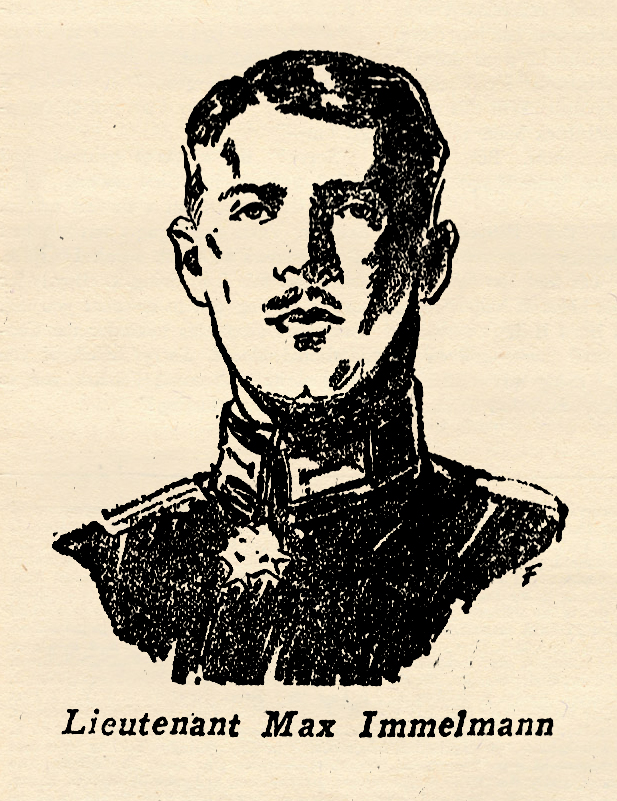My Most Thrilling Sky Fight: Lieutenant Max Immelmann
Amidst all the great pulp thrills and features in Sky Fighters, they ran a true story feature collected by Ace Williams wherein famous War Aces would tell actual true accounts of thrilling moments in their fighting lives! This time we have Lieutenant Max Immelmann’s most thrilling sky fight!
LIEUTENANT Max Franz  Immelmann was the first of the great German Aces. Immelmann scored victory after victory over the Allied flyers until his total score mounted higher than that of any of the Allied Aces.
Immelmann was the first of the great German Aces. Immelmann scored victory after victory over the Allied flyers until his total score mounted higher than that of any of the Allied Aces.
He was an excellent gunner and as a flyer had no peer during his time. He was the first to use the quick Climbing reverse turn, which was the fastest method of changing direction while in full flight. The maneuver first demonstrated by Immelmann in his sky battles over the Western front has since been named after him, the Immelmann turn. It was a very effective maneuver and enabled him to gain many victories. He and Oswald Boelke served in the same Squadron. When he was killed Boelke went on to surpass his records, only to be surpassed himself after he was killed, by Baron von Richthofen.
None of the American flyers, except those flying with the French, ever encountered Immelmann in the air. He was killed in 1918 before America entered the war. The account below was told to a newspaper correspondent.
TWO OUT OF THREE
by Lieutenant Max Immelmann • Sky Fighters, January 1934
AIR fighting is like any other kind of fighting. Victory goes usually to the strongest and best prepared. The French have tried to make it more romantic, like the fighting of the knights of old, man to man in bold, open fighting on mounted chargers. That is spectacular and picturesque. I do not believe it the best method. The object in war is to down as many of the enemy planes as is possible without losing any of your own. Thus you may obtain the mastery of the air, which is necessary in this modern war, if the ground troops are going to win success.
For that reason I have adopted tactics which seem on the surface prudent. I aim to destroy the enemy without letting them destroy me. My methods are best explained by giving an example. Three days ago, I was out cruising the lines with my patrol. We were in layer formation. One was far below, leading. Two others were further back of him and higher up, one on either side. I brought up the rear, directly behind the leader, and higher up than any of them.
While flying in that formation, the leader encountered a patrol of three Frenchmen. His instructions were to fly on until attacked, which he did. My patrol never even let on that they saw the approaching formation. They flew along parallel with the lines in steady flight without changing elevation. I throttled down my machine and dropped back, until the rest of my patrol was just mere specks. Then I shoved on full throttle and climbed for the sun.
The Frenchmen drove in for the attack on the three German planes below. My men kept their formation until the bullets began to get too close, then they returned the fire and adopted defensive tactics. At the same time, they retreated back over our lines, to draw the enemy over our territory. They were making a running fight of it, according to instructions, diverting the attackers’ intentions all to themselves; but knowing all the time that I would be diving down unawares from the disc of the sun behind to pounce upon the enemy in surprise.
And I did. I dived straight down from the well of the sun, my fingers poised over the gun trips. At one hundred yards I opened up on the first Frenchman. My tracers bored through his cockpit and he went spinning down. But not before I had dived underneath him to zoom up again with my guns pointed at his nearest comrade.
I opened up on him, saw my tracers eating into his belly. One plane was down now. I had the position on the second, and the first shots in. My comrades then, all banked and raced in for attack on the third Frenchman. He fought them bravely, I must admit, returning burst for burst. But he was doomed from the first with three against one.
My opponent slipped from my tracer stream, and nosed down towards his own lines. I zoomed up, half-rolled (Immelmanned—Ed.), changed direction and went streaking after him, still pouring tracer. Glancing back over my shoulder I saw the second enemy break apart beneath the guns of my mates. His plane fell to pieces and went fluttering down.
When I looked forward again, my opponent had dived and won away from me. I nosed down and went after him, but he went even faster for a forced landing just on the other side of his own lines where his ship upended in a shell crater and smashed one wing.
That was the end of the fight. Two French ships had been destroyed in our own territory. The other had been forced down to a crash landing just out of our reach. That was poor strategy on my part. I should have headed him off, making him land on our side. However, my patrol was still intact. Next time, I vowed I would not make such a slip. With perfect strategy and tactics properly executed, we would have accounted for all three enemy ships over our own territory.




